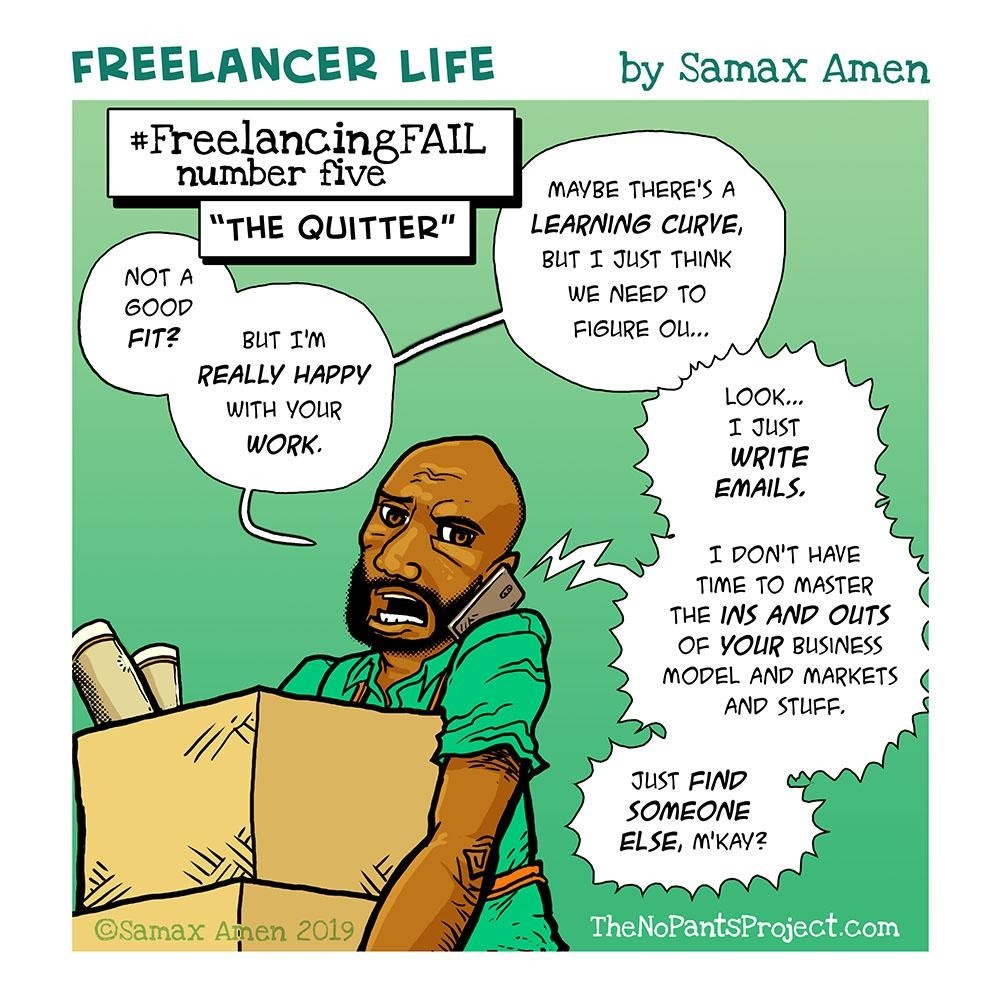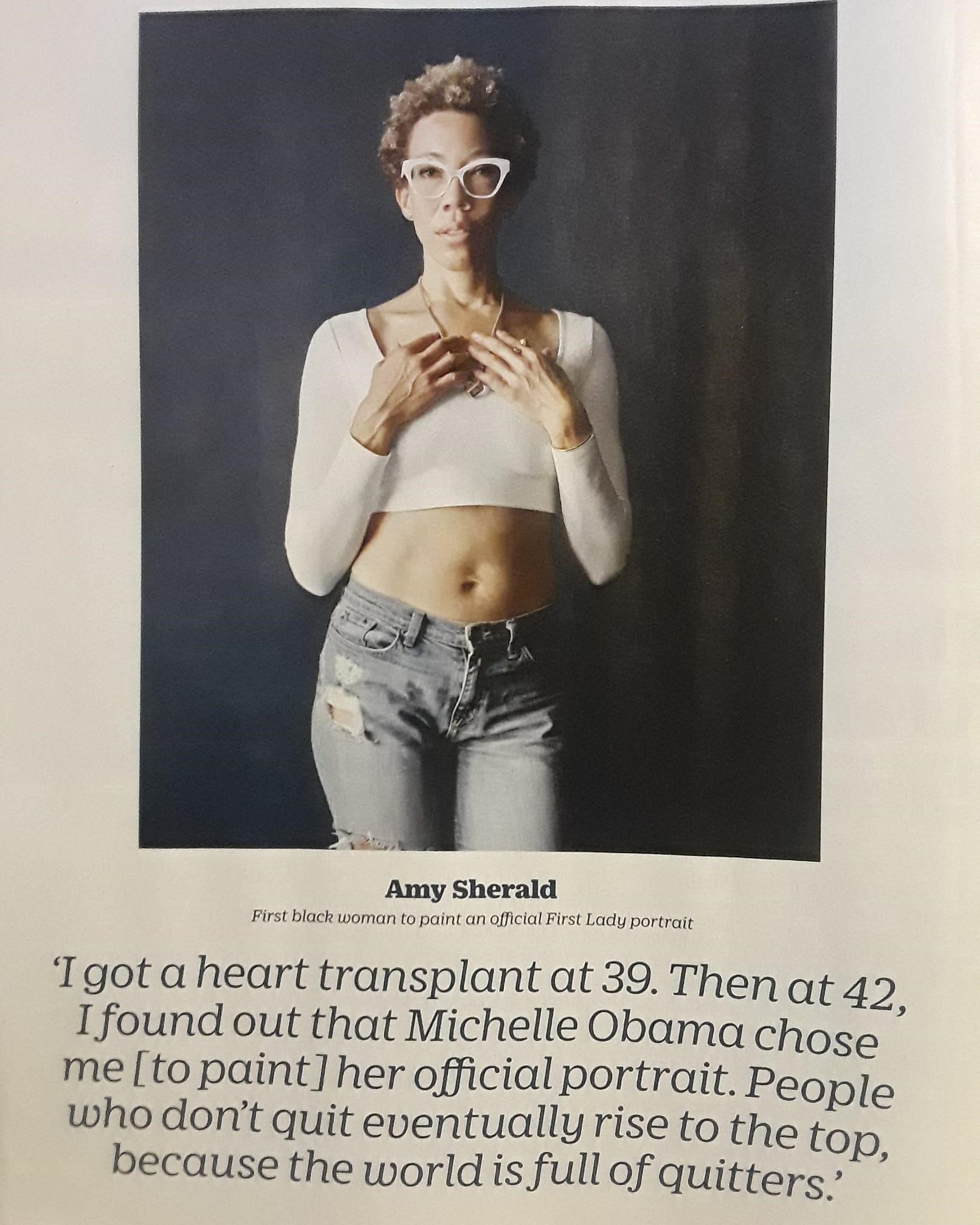Are you thinking about quitting your freelancing business?
If so, it’s probably because you think that having the life and business you want is too complicated. (It’s actually pretty simple, if not easy).
You think the reason your freelancing business is struggling is that you don’t know the right people, or that you don’t have enough money, or you don’t have enough time, but that’s not it.
Maybe you think your business is doomed because you never went to college, or you have a criminal record, or you have terrible credit. That’s not it, either.
Any of those situations, and many others like them, can be a real pain when you’re trying to build a business. But succeeding is not so much about the circumstances you find yourself in, as it is about the way you respond to your circumstances.
If you feel like you’re always working hard, but never getting a breakthrough to real success in your creative business, this is for you!
#FreelancingFAIL is a series of comic strips and blog posts about the mindsets and behaviors that cause freelancers to struggle, and how to overcome them.
Part Two: The Stubborn Artiste details the massive benefits of practicing empathy in your business.
Part Four: The Ghost lays out several benefits of embracing authentic professionalism.
#FreelancingFAIL Part Five is about Quitting.
Don’t get me wrong, there are definitely times when you should quit.
- Safety issues. Although I am a big fan of empathy in business, you have to always remember to practice self-care. Putting yourself at undue physical, emotional, or financial risk is not required. Remember, you are the most valuable asset in your business!
- Values mismatch. The last full-time job I worked REALLY made me feel like a bad person. The company was in a sector I felt guilty working in, headed by leadership that were observably bad people. Working for them soured me on the entire industry. Getting out was a spiritual necessity. As much as I like making money, the values have got to be compatible.
- End of an Era. Some relationships (including business relationships) just have an expiration date. Sometimes, it’s just time to part ways.
When it’s time to move on, just make sure you do it professionally. Your reputation (and your conscience) are valuable assets, too! So protect yourself by keeping all your exits as classy as possible.
Even though quitting is sometimes appropriate, it’s often just a way to avoid the discomfort and growing pains of building something worthwhile.
According to Kelley and Conner’s Emotional Cycle of Change, when you voluntarily start something new, you are energized by something called Uninformed Optimism, and motivation comes easily. When this honeymoon period wears off, perhaps because you’ve hit difficulties, Informed Pessimism kicks in.
At this stage of the cycle, many freelancers start looking for excuses to abandon what they’re doing to seek out the warm fuzzy feelings of Uninformed Optimism again. This loop is called Shiny Object Syndrome.

“One of the most common causes of failure is the habit of quitting when one is overtaken by a temporary defeat.”
–Napoleon Hill (Think and Grow Rich)
Many people come across a technique for freelancing successfully and are immediately skeptical about whether it really works or not. The reality is, if you learn a strategy from someone who makes their living that way, it probably still works.
IF you’re willing to work at it.
The problem that comes up is that people quit.
Many quit before they’ve even begun, usually because of fears based on myths about starting a freelancing business.
Others quit because they run out of enthusiasm. In other words, they have trouble staying motivated. There is something much better than motivation, and we’ll detail what it is, and how to prime yourself every single day, so you can get the results you need.
Motivation VS Discipline
“Motivation is complete garbage…” says Mel Robbins, author of The 5 Second Rule. “We all bought into this lie that you gotta feel ready.” The fact is, motivation is often just a feeling, and it is a big mistake to count on your feelings to be the backbone of your business.
Mike Shreeve seconds Mel’s teaching on The No Pants Show podcast. “Everything you want you can only get after you break yourself free from the control that feeling has on you.”
Fear, doubt, confusion and their emotional cousins tend to distract and divert us away from the actions we need to take at any given time.
Like Robbins, Shreeve places a heavy emphasis on habitual action.
“Discipline is the bridge between goals and accomplishment.” -Jim Rohn
While we recommend that you consume positive content that affirms your goals, you are asking for trouble if you neglect to focus on discipline and perseverance.
As the saying goes, “faith without works is dead.”
Where counting on motivation often leads to quitting when the motivation doesn’t come (because it’s easy to blame yourself and adopt a self-defeating narrative that you don’t have what it takes), discipline is about showing up every day and doing what it takes to succeed, whether you feel successful or not.
Michelle Obama’s Portrait Artist Shares Secret to Success

Growing up in the South, Amy Sherald felt that she grew up in a restrictive culture that sought to limit her because of her gender and race.
She chose the uphill climb of making her way as an artist in a family that didn’t see that as a valid career choice, waiting tables to support herself into her late thirties. She didn’t let difficulty stop her, even heart failure.
“Success, for me,” Sherald muses, “is staying true to who you are and not deviating off a path.”
This artist’s work-smart attitude can teach you something about how to pursue your freelance journey:
Be strategic and persistent, because persistent action pays off.
So here are six smart ideas you can apply to your freelance business right now.
6 Ways To Be More Disciplined
In The No Pants Show podcast episode, 2 Things You Can Do To 10x Productivity, Mike Shreeve lays out how you can develop discipline to the extent that you can be very efficient, while working limited hours. This is hard at first, but once these become habits, you’ll reap some serious benefits!
Besides helping you make more money with less daily effort, getting the right habits will ensure that you are not tempted to quit!
1) Kill Distractions during work hours. Set times when you are working, and save work time for work.
No Facebook. No Youtube. No phone calls. If you need to do research to write, set time to research, and time to write. Don’t let things you could be doing distract you from what you need to be doing right now.
Creating rules for yourself, and using apps that protect you from distractions is totally worth doing!
2) Determine your One Thing. The book The One Thing by Gary Keller and Jay Papasan introduces the concept of a Focusing Question: “What’s the One Thing that I could do such that by doing it everything else would be easier or unnecessary?”
It’s a challenging question, but worth answering! When you can answer that question, it becomes easy to make decisions.
Like the 80/20 Rule, or the Could Vs Should Mental Framework, The One Thing’s Focusing Question is all about establishing priorities.
Once you have determined what’s truly important to you, be disciplined in enforcing it. Not only will it tell you what to do, but it will give you the power of saying no!
3) Set Quarterly Goals. Decide what’s important to you and set goals for the next ninety days. Decide what you want to achieve and how you want to improve. Based on your quarterly goals, break it down into digestible action items. Then use those to fill your Daily Roadmap!
4) Create a Daily Roadmap. Your business as a freelancer should be simple enough that a few daily actions repeated over time will get you the result you’re looking for. You can consistently schedule time blocks that you do every day, so that they are helping you reach your goals.
EXAMPLE:
- Marketing activity 9:00-10:00: Write daily email, work on Facebook ads, Cold emails, etc.
- Client Work 10:00-12:00: Whatever you do for your clients (writing sales letters, designing logos, building websites, etc.)
- Client Relations Noon-1:00: Checking/answering client emails, phone appointments with clients, etc.
- Closing Up Shop: At the end of the business day, Get Clarity on what you will do tomorrow, and fill out the next day’s copy of the roadmap.
The length and types of time blocks are up to you, it’s just an example of how you can structure things. You can hear more about the Daily Roadmap from Mike Shreeve in Episode 29 of The No Pants Show, 2 Things You Can Do To 10x Productivity.
5) Devote some time to fun and loved ones. Much like the time you devote to work, there needs to be time devoted to family, friends, and fun. Like you protect work time for work, leave work at work and have some fun/family time.
6) Expect it to be hard. You will have trouble doing this at first. You are establishing new habits, which is hard. But not impossible! Just remember to be gracious but firm with yourself. The difficulty is good news! It means that if you are willing to do the work, you will leave your competitors behind.
Sound simple? That’s because it is.
Not easy, but simple.
If you can get some clarity, eliminate distractions, focus in on the things that really matter, and get efficient in your work, while also saving some time for fun and self-care, achieving real success is just a matter of time.
Wanna see how it’s done?
The No Pants Project is designed to help you build a simple business around your skills, passions, and desires that attracts premium clients you will love working with. Click here to check out the Case Study and learn how Mike Shreeve built a $26,500/month freelance business from scratch!













